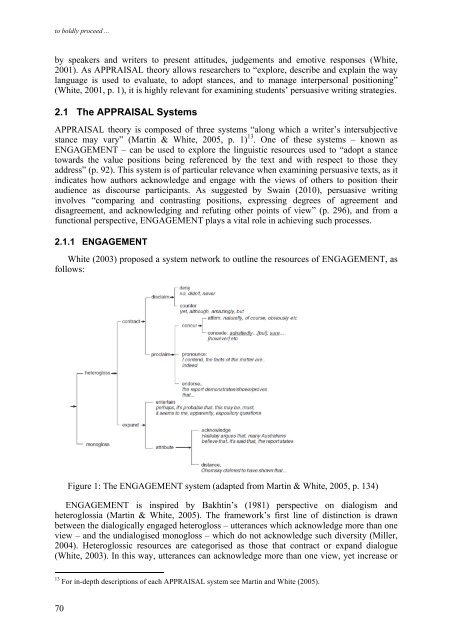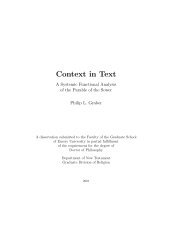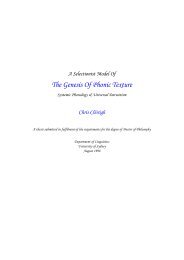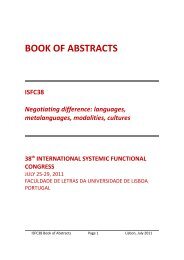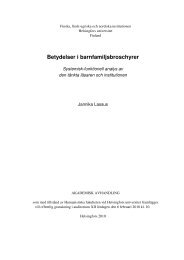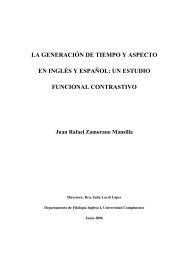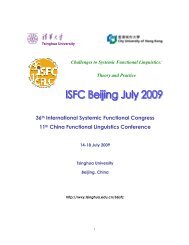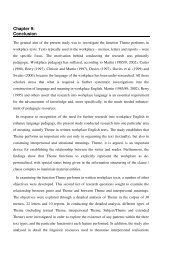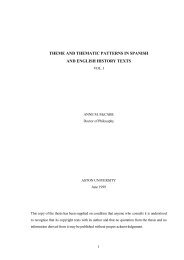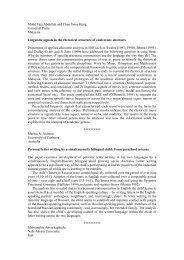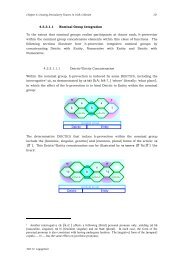to boldly proceed ...by speakers and writers to present attitudes, judgements and emotive responses (White,2001). As APPRAISAL <strong>the</strong>ory allows researchers to “explore, describe and explain <strong>the</strong> waylanguage is used to evaluate, to adopt stances, and to manage interpersonal positioning”(White, 2001, p. 1), it is highly relevant for examining students’ persuasive writing strategies.2.1 The APPRAISAL SystemsAPPRAISAL <strong>the</strong>ory is composed of three systems “along which a writer’s intersubjectivestance may vary” (Martin & White, 2005, p. 1) 13 . One of <strong>the</strong>se systems – known asENGAGEMENT – can be used to explore <strong>the</strong> linguistic resources used to “adopt a stancetowards <strong>the</strong> value positions being referenced by <strong>the</strong> text and with respect to those <strong>the</strong>yaddress” (p. 92). This system is of particular relevance when examining persuasive texts, as itindicates how authors acknowledge and engage with <strong>the</strong> views of o<strong>the</strong>rs to position <strong>the</strong>iraudience as discourse participants. As suggested by Swain (2010), persuasive writinginvolves “comparing and contrasting positions, expressing degrees of agreement anddisagreement, and acknowledging and refuting o<strong>the</strong>r points of view” (p. 296), and from afunctional perspective, ENGAGEMENT plays a vital role in achieving such processes.2.1.1 ENGAGEMENTWhite (2003) proposed a system network to outline <strong>the</strong> resources of ENGAGEMENT, asfollows:Figure 1: The ENGAGEMENT system (adapted from Martin & White, 2005, p. 134)ENGAGEMENT is inspired by Bakhtin’s (1981) perspective on dialogism andheteroglossia (Martin & White, 2005). The framework’s first line of distinction is drawnbetween <strong>the</strong> dialogically engaged heterogloss – utterances which acknowledge more than oneview – and <strong>the</strong> undialogised monogloss – which do not acknowledge such diversity (Miller,2004). Heteroglossic resources are categorised as those that contract or expand dialogue(White, 2003). In this way, utterances can acknowledge more than one view, yet increase or13 For in-depth descriptions of each APPRAISAL system see Martin and White (2005).70
Papers from <strong>the</strong> 39th ISFCdecrease an interpersonal cost for any reader who objects to <strong>the</strong> position presented by <strong>the</strong>authorial voice (Martin & White, 2005). While a detailed account of each resource can befound in White (2003) or Martin and White (2005), this short paper highlights <strong>the</strong> four mostcommonly used ENGAGEMENT resources in <strong>the</strong> data set, namely: monoglossic utterances;ENTERTAIN; DENY; and AFFIRM.3 Classical RhetoricThe second view of language used to examine <strong>the</strong> data set is classical rhetoric, <strong>the</strong> originsof which lie in 5 th Century BC Greece (Kennedy, 1999). Classical rhetoric is chieflyassociated with persuasive discourse, and consists of numerous linguistic resources that assistspeakers or writers to persuade o<strong>the</strong>rs (Corbett & Connors, 1999). For pedagogical purposes,classical rhetoric has been split into five canons, or parts, which can be drawn from to assistspeakers and writers to invent, arrange, stylise, memorise, and deliver persuasive texts.Important to <strong>the</strong> third canon, known today as STYLE, are a number of linguistic rules thatcan be used to add a sense of balance to arguments, emphasise and restate key points, achievesmooth transitions between parts of a text, improve syntax and clarity, increase dramaticelements, and produce euphony and rhythm in <strong>the</strong> language used (Harris, 2003). In fact,Corbett and Connors (1999) described <strong>the</strong> basis of STYLE as <strong>the</strong> composition of words inphrases or clauses, with specific rules outlined for speakers and writers to achieve numerousrhetorical purposes. These rules for stylising text are commonly referred to as figures ofspeech.3.1.1 Figures of SpeechAll figures of speech are classified as schemes (meaning form) or tropes (meaning to turn)(Corbett & Connors, 1999). Schemes are characterised by a transference of regular wordorder, as in Winston Churchill’s speech in <strong>the</strong> House of Commons, when he stated:We shall fight on <strong>the</strong> beaches, we shall fight on <strong>the</strong> landing-grounds, we shall fight in <strong>the</strong> fields andin <strong>the</strong> streets, we shall fight in <strong>the</strong> hills (June 4, 1940).This is an example of anaphora, a figure of speech where <strong>the</strong> same word or words arerepeated at <strong>the</strong> beginning of successive phrases, clauses, or sentences (Harris, 2003).Alternatively, tropes are characterised by transference of regular meaning, as in metaphorwhere two different things are compared by speaking of one in terms of <strong>the</strong> o<strong>the</strong>r (Harris,2003). Although more than 200 figures of speech have been identified (Joseph, 1947), 33were selected for this research from <strong>the</strong> work of Harris (2003) and Corbett and Connors(1999), as being particularly relevant for modern day students. Corbett and Connors (1999)stressed <strong>the</strong> need for teachers to draw attention to this aspect of students’ writing, as itincreases <strong>the</strong>ir awareness of <strong>the</strong> figurative resources <strong>the</strong>y deploy, often unconsciously. Inaddition, <strong>the</strong> principles of rhetoric can be used to analytically break down <strong>the</strong> persuasive textsof o<strong>the</strong>rs, exposing <strong>the</strong> rhetorical strategies <strong>the</strong>y used to stylise <strong>the</strong>ir arguments (Corbett &Connors, 1999). This paper highlights four commonly used figures by <strong>the</strong> year 5 students,and explains where <strong>the</strong>y were paired with resources of ENGAGEMENT.4 Data AnalysisTo discover <strong>the</strong> linguistic resources used by <strong>the</strong> fifteen year 5 students, <strong>the</strong>ir texts wereimported into NVivo 9 and coded for instances of <strong>the</strong> 17 ENGAGEMENT resources (White,2003; Martin & White, 2005) and <strong>the</strong> 33 figures of speech (Harris, 2003; Corbett & Connors,1999).71


